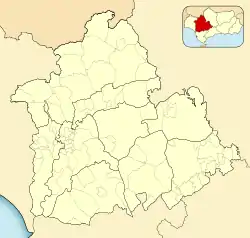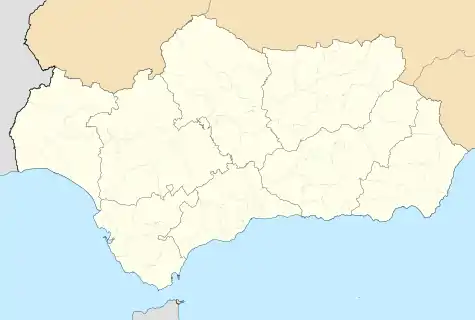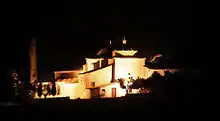Guadalcanal, Seville
Guadalcanal (Spanish pronunciation: [ɡwaðalkaˈnal]) is a village in the province of Seville, in the autonomous community of Andalusia, Spain.[2]
Guadalcanal | |
|---|---|
 | |
.svg.png.webp) Coat of arms | |
 Guadalcanal  Guadalcanal  Guadalcanal | |
| Coordinates: 38°05′N 5°49′W | |
| Country | |
| Autonomous community | |
| Province | |
| Comarca | Sierra Norte de Sevilla |
| Population (2018)[1] | |
| • Total | 2,646 |
The name was given to the island of Guadalcanal in the Solomon Islands in 1568. The name was chosen by Pedro de Ortega Valencia who had been born in the village. He was a subordinate of Spanish explorer and navigator Álvaro de Mendaña de Neira.
Location and population
In 2006 there were 2,970 inhabitants. It has an area of 275 square kilometres and a population density of 10,6 people per square-km. It is at an altitude of 662 metres, in a valley between the Sierra del Agua and the Sierra del Viento, in the region of the Sierra Norte of Seville. Guadalcanal is 80 kilometres north of Seville, it depends to the judicial party of Cazalla de la Sierra
Etymology
The name, etymologically, might come from the Arabic phrase وَادِي الْقَنَالْ wādī l-qanāl, meaning "river of the stalls" or "valley of stalls", referring to the refreshment stalls set up there during the Muslim rule in Andalusia. But it is more likely to be a mixture of Arabic "Wad" (river) and Spanish "del Canal" (of the canal). Other names were Tereses or Tereja or Canani with the Iberians.
History



It was reconquered by the Order of Santiago in 1241 from the Moors, then Guadalcanal belonged to the Kingdom of León as well as other parts of Extremadura. In ecclesiastical terms, it belonged to the Santa María de Tendudia vicary.
Guadalcanal was fortified by means of a now-ruined wall which was demolished because the village took part in the Guerra de las Comunidades de Castilla.
In the mid-16th century, the area had some silver mines financed by the Fugger family.
The village suffered a crisis in the 19th century, which caused the four nunneries in the village to close. As other rural communities in Spain, it faced a massive exodus of its inhabitants to the cities in the 20th century.
References
- Municipal Register of Spain 2018. National Statistics Institute.
- Williams, Jo (2016-04-17). "Guadalcanal, villages in the province of Seville Andalucía, Southern Spain". Andalucia.com. Retrieved 2016-04-22.
External links
- Página web oficial del Ayuntamiento de Guadalcanal
- Guadalcanal – Sistema de Información Multiterritorial de Andalucía
- Información de Guadalcanal
- Guadalcanal Cofrade – Página con la actualidad cofrade de Guadalcanal.
- Página web del pintor Fernando Díaz Mirón
- Mirador La Capitana en el término municipal de Guadalcanal
- Vídeos de Guadalcanal